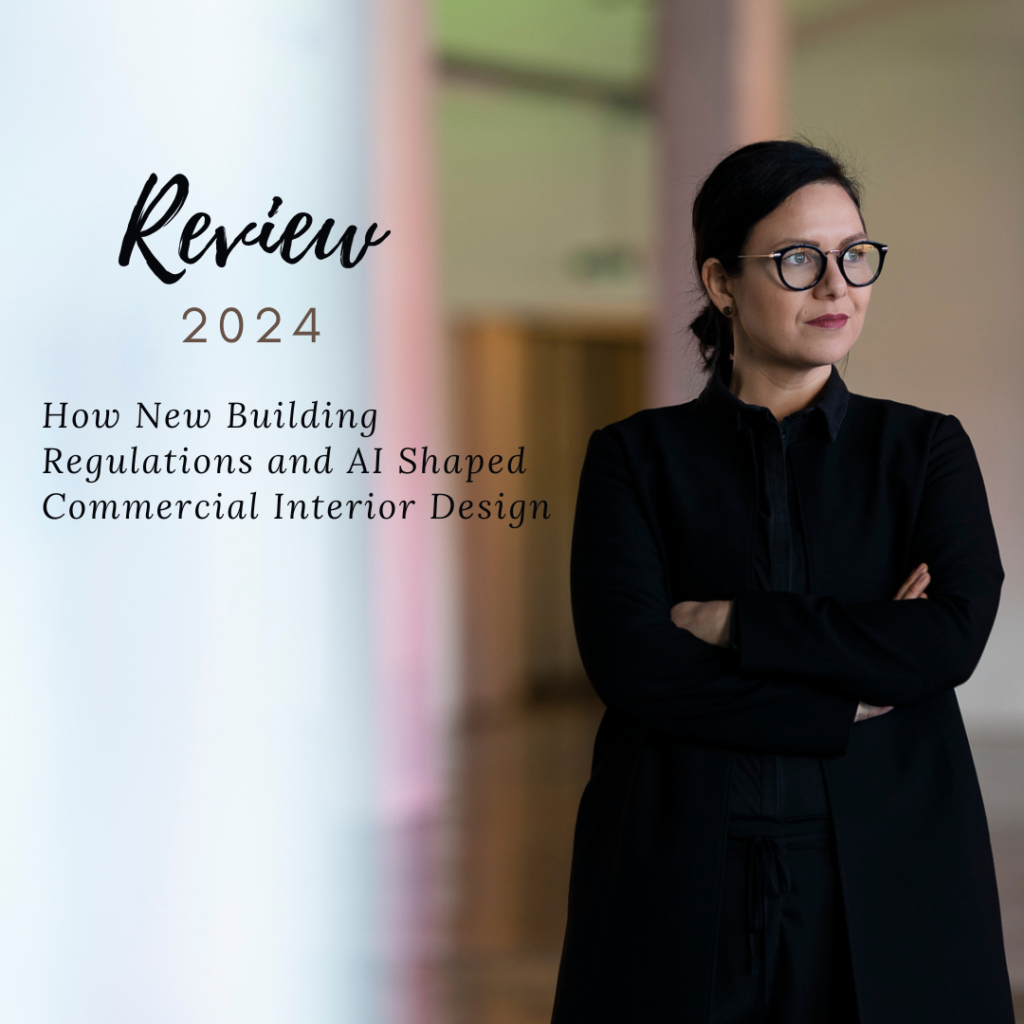Sustainability in branch construction is now far more than just a trend or niche topic—it has become a necessity.
Although sustainable building in structural engineering has been established through various political regulations or committed activists, interior construction can still hide behind several counterarguments.
Companies that plan and operate their branches sustainably benefit not only from a positive public image but also from long-term savings in energy and operating costs. Sustainability doesn’t need to be ingrained in the company’s identity to achieve this.
In this article, you will learn which short- and long-term measures are particularly suitable for the construction and operation of branches to be optimally positioned both ecologically and economically. And since I know how important costs are, I have included a rough cost estimate for each measure.
Feel free to contact me, and I will develop a tailored strategy with a cost framework for your branch.
Short-term Measures: First Steps for Quick Success
Energy Savings through Intelligent Control Systems
A quick way to reduce energy consumption in existing branches is by retrofitting smart control technologies.
These systems automatically adjust heating, cooling, and lighting based on the usage of the spaces, thereby avoiding unnecessary consumption.
Smarter Use of Lighting
Sure, we all know it, yet there are still so many branches using halogen lighting… By replacing outdated lamps with LED bulbs and integrating motion sensors, lighting can be controlled as needed. This can save up to 50% of energy consumption.
Estimated cost for a 100 sqm branch:
40 LED bulbs: €800
4 motion sensors: €400
Labour costs: €1,000
Total cost: €2,200
The investment would pay off in approximately one year (1.05 years), depending on the exact operating hours and energy prices.
Smart Air Conditioning Control
Systems like those from tado° or Mitsubishi Electric RMI offer central control options that can be networked across multiple locations. With the help of motion and temperature sensors, the air conditioning is regulated according to demand, significantly reducing energy consumption. (tado°) (Mitsubishi Electric LES).
Cost estimate:
tado° or Mitsubishi Electric RMI systems range in price between €500 and €2,000 for a small to medium system that integrates motion and temperature sensors and centrally controls the air conditioning.
Installation costs: Depending on the region and complexity, additional installation costs of around €1,000 to €1,500 may apply.
Total cost: €1,500 – €3,500
Savings:
A smart air conditioning control can reduce energy consumption by approximately 20-30%, as the system only runs when necessary. Assuming annual air conditioning costs are around €2,500 (with typical energy costs in a city centre location): Savings: €500 – €750 per year
Payback period:
With the savings mentioned, the investment would pay off in about 2 to 5 years, depending on the exact installation costs and savings potential.
Dynamic Cooling Technology
Modern cooling devices with dynamic cooling technology adjust their performance based on actual usage and outside temperature. These systems are particularly efficient, as they don’t run at maximum power constantly but automatically adapt to demand. This saves both electricity and maintenance costs. Such systems could be implemented in refrigerated shelves or fresh food counters.
For the implementation of dynamic cooling technology in a standard supermarket, the following estimates for costs and payback time can be made:
Costs for dynamic cooling technology:
Cooling devices with dynamic cooling technology: The costs vary depending on the size and capacity of the cooling units. For an average supermarket, the costs for purchasing and installing such systems could range between €10,000 and €50,000, depending on whether only refrigerated shelves or also fresh food counters are to be equipped.
Savings and Payback Time:
Savings potential: Dynamic cooling technology can reduce energy consumption by up to 30%, as cooling performance is adjusted to actual demand. In a standard supermarket, annual electricity costs for cooling could range between €10,000 and €20,000.
Savings: €3,000 to €6,000 per year.
Payback time:
Depending on the installation costs and the savings achieved, the investment would pay off in approximately 2 to 8 years.
The exact figures depend heavily on the size of the market, the number of cooling units, and specific operating conditions.
Air Quality and CO2 Sensors
Many branches operate ventilation and air conditioning systems at full capacity, even when air exchange is not necessary. CO2 sensors can measure the carbon dioxide levels in the air and activate the ventilation system only when air quality declines. Such systems optimise air exchange and prevent unnecessary energy loss from continuous ventilation.
Supermarket:
Costs: Approximately €2,000 – €4,000 for the installation of a CO2 sensor system connected to the ventilation systems.
Savings: A reduction in energy consumption through demand-based ventilation can amount to around 20-30%. For a ventilation system with annual costs of around €10,000, this results in savings of €2,000 – €3,000 per year.
Payback time: 1-2 years.
100m² standard branch:
Costs: Approximately €1,000 – €2,000.
Savings: Around €500 – €1,000 per year with a smaller ventilation system, as less ventilation is needed.
Payback time: 1-2 years.
Smart Window Coatings or Films
Thermally adaptive window coatings or retrofit smart window films adjust to light conditions. They reduce solar heat gain in summer and provide better insulation in winter, significantly lowering heating and cooling demands. This technology is still relatively unknown but offers great potential for energy savings.
Branches with large window surfaces:
Costs: Approximately €100 – €200 per square metre for smart window films or thermally adaptive coatings. For a branch with around 100 m² of window surface, total costs could range from €10,000 to €20,000.
Savings: These systems can reduce heating and cooling needs by about 20%, leading to annual savings of €2,000 to €4,000.
Payback time: 5-10 years, depending on the window surface area and energy consumption.
Branches with covered window surfaces (e.g., pharmacies, offices):
Costs: Slightly lower, as these areas are often smaller, but still around €100 – €200 per m² for the films.
Savings: Approximately €1,000 – €2,000 per year.
Payback time: 3-5 years.
On-Demand Water Heating
Branches often waste energy by maintaining hot water over extended periods. Modern instantaneous water heaters, which heat water only when needed, can be installed quickly to reduce energy consumption. These systems are particularly efficient in washrooms and kitchen areas.
A 100m² branch with 3-4 water outlets:
Costs: Approximately €1,000 – €1,500 for modern instantaneous water heaters.
Savings: 20-30% savings on annual hot water costs, around €200 – €400.
Payback time: 2-4 years.
Gastronomy area with higher water usage:
Costs: For larger systems, approximately €2,500 – €5,000.
Savings: €1,000 – €2,000 per year, depending on usage.
Payback time: 2-3 years.
Energy-Optimised Refrigeration and Freezer Units with Night Covers
Refrigeration units in branches often run continuously, even when not in use at night. Night covers for refrigerated shelves and freezers are a simple way to reduce energy consumption outside of business hours. They prevent cold air from escaping the units, leading to significant savings.
Supermarket:
Costs: Night covers cost around €1,000 – €2,000 per refrigeration or freezer unit.
Savings: Up to 30% energy savings at night, which could amount to €2,000 – €5,000 per year for multiple units.
Payback time: 1-2 years.
Predictive Maintenance for Systems (e.g., air conditioning, heating, refrigeration units)
With the help of IoT- and AI-based predictive maintenance solutions, branches can detect when maintenance is needed for devices such as air conditioning, heating, or refrigeration units before a breakdown occurs. This prevents inefficient operation and saves energy costs.
Standard 100m² branch:
Costs: Approximately €5,000 – €10,000 for the implementation of IoT- and AI-based solutions to monitor the condition of systems.
Savings: Reduction of maintenance costs and energy losses from inefficient equipment by about 10-20%, resulting in annual savings of €1,000 – €2,000.
Payback time: 3-5 years, depending on the frequency of maintenance and the equipment in use.
Automatic Load Management Systems
These systems monitor and control the energy consumption within the branch by dynamically adjusting devices and lighting to the current demand. When energy consumption is particularly high during peak times, they automatically reduce the power of devices or shift energy-intensive processes to off-peak periods.
Supermarket:
Costs: Approximately €3,000 – €6,000, depending on system complexity and the number of devices to be controlled (lighting, refrigeration, heating).
Savings: Around 10-20% of total energy consumption, which could mean savings of €2,000 – €4,000 per year in a supermarket with energy costs of around €20,000.
Payback time: 1.5 – 3 years.
100m² standard branch:
Costs: Approximately €1,500 – €3,000.
Savings: With estimated energy costs of €5,000, savings of €500 – €1,000 per year could be achieved.
Payback time: 1.5 – 3 years.
Occupancy and Zoning Sensors
While lighting and heating systems are often controlled by motion detectors, new systems offer additional zoning control and occupancy sensors. These systems not only detect the presence of people but also how long they remain in a specific area, adjusting the temperature and lighting accordingly.
Supermarket:
Costs: Approximately €1,000 – €3,000, depending on the number of zones and sensors.
Savings: 10-15% savings in energy consumption for lighting and heating. With energy costs of €10,000 for lighting and heating, this could amount to €1,000 – €1,500 per year.
Payback time: 1 – 2 years.
100m² standard branch:
Costs: Approximately €500 – €1,500, depending on the number of zones.
Savings: €500 – €1,000 per year.
Payback time: 1 – 2 years.
Smart Ventilations
Supermarket:
Costs: Approximately €300 – €800 per fan. For an average market, 4-6 fans may be needed, resulting in total costs of €1,200 – €4,800.
Savings: Smart fans can reduce air conditioning energy consumption by 10-15%. With cooling energy costs of around €10,000, savings of €1,000 – €1,500 per year could be achieved.
Payback time: 1 – 3 years.
100m² Standard Branch:
Costs: Approximately €300 – €800 per fan, with 2-3 fans totalling €600 – €2,400.
Savings: €200 – €400 per year.
Payback time: 2 – 4 years.
Energy Management through AI and Algorithms
By using artificial intelligence (AI) and machine learning, building management systems can proactively optimise energy demand based on historical data and real-time factors such as weather conditions or customer numbers. This allows for more efficient energy use and prevents unnecessary peak consumption.
Supermarket:
Costs: €10,000 – €30,000 for the implementation of an AI-based energy management system that controls various systems (lighting, heating, cooling).
Savings: 10-20% savings in total energy consumption, which could mean savings of €2,000 – €4,000 per year with energy costs of €20,000.
Payback time: 3 – 7 years, depending on implementation costs and the savings potential achieved.
100m² Branch:
Costs: €5,000 – €15,000.
Savings: €500 – €1,500 per year.
Payback time: 3 – 7 years.
Use of Waste Heat
For branches with large refrigeration systems, using waste heat can be an effective solution. The heat generated from cooling can be used to heat water or office spaces. This is a simple and effective method to utilise existing energy multiple times.
Supermarket:
Costs: €5,000 – €15,000 for integrating a system that utilises waste heat from refrigeration units to heat water or office spaces.
Savings: Depending on the amount of waste heat, savings of €1,500 – €3,000 per year in heating or hot water costs could be achieved.
Payback time: 2 – 5 years.
100m² Branch:
Costs: Likely more suited for larger markets, but if relevant, the costs for a small system could range from €5,000 to €10,000.
Savings: Approximately €500 – €1,000 per year.
Payback time: 5 – 10 years.
Resource Conservation through Water-Saving Technologies
Faucets and sanitary facilities are often underestimated when it comes to savings. Even though water consumption may not be a primary focus for many retailers, modern solutions can significantly reduce it:
Water-saving faucets from Grohe or Hansgrohe: These brands offer faucets equipped with technologies like flow limiters, which can halve water consumption without sacrificing comfort.
Adjustable flow rates: By installing regulators, such as those offered by Neoperl, existing faucets can also be retrofitted and optimised.
Long-term Measures: Sustainability as a Strategic Decision
Sustainable Branch Design from the Start
Environmental aspects and energy efficiency should be prioritised right from the planning phase of a new branch. This starts with the selection of building materials and extends to flexible space planning, enabling future adjustments with minimal effort:
Modular construction: Opt for a concept where spaces can be easily reconfigured. This saves materials in the long run and reduces waste when renovations are needed.
Cradle-to-Cradle approach: When choosing building materials, it is advisable to use circular products that can either be fully recycled or reused after their lifecycle. Please also take a look at my post for circula economy and cradl-to-cradl.
Use of Renewable Energies
Branches that meet at least part of their energy needs independently are more sustainable in the long term and also save costs:
Photovoltaic systems: For branches with large roof areas, installing photovoltaic systems is ideal. These can either feed excess energy into the power grid or be used for self-consumption.
Geothermal energy and heat pumps: These technologies utilise natural heat sources and are particularly efficient when paired with a modern building envelope.
Rainwater Harvesting in Branches – Best Practice
Some companies are already successfully using rainwater to minimise water consumption:
Aldi Süd: In addition to an extensive, sustainable property concept, the company also uses rainwater for outdoor irrigation in some of its branches, setting a clear example for sustainable branch designs.
IKEA: In various countries, rainwater harvesting systems are used to supply water for toilet flushing or garden irrigation.
Conclusion: Sustainability in Branch Construction as a Success Factor
A sustainable Storeconstruction is not only an investment in the environment, but also in the future of your company. Short-term measures create quick successes, long-term strategies form the basis for efficient and environmentally friendly operations.
There is no one perfect solution – every company should find an individual way to design its branch construction in a sustainable and future-proof manner.
Would you like to find out more? I would be happy to accompany you in creating an energy saving strategy and a sustainable branch portfolio.
Leave me a message – I will be happy to send you the free list of manufacturers for the various components and trades, sustainable technologies.



